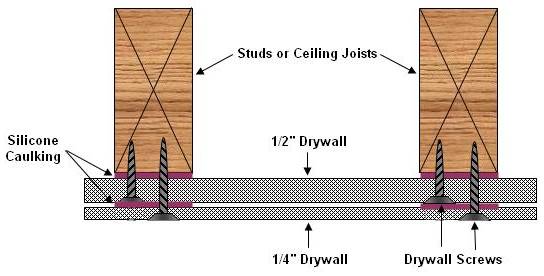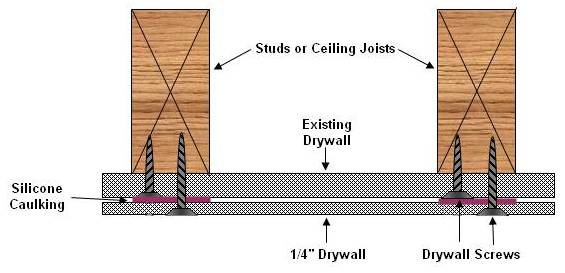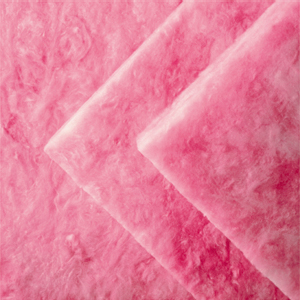
But noise pollution is also created indoors by day to day noises of just walking on floors above living areas. As well as noises created by running and draining water.
This article is written for homes that are already constructed. There are additional remedies for homes that are in design stages.
Additional information on sound proofing homes that are in design stage.

Figure 1a - Triplex
These techniques work well in multi-occupancy buildings such as condominiums and in duplex, triplex (Figure 1a) and row housing, where sounds are transmitted between units.
Sound travels through solid objects much easier than through air. As an example, carpeting is a much better sound attenuator than hardwood or ceramic tile, and the reason is the difference in the density of each of the materials.
When deciding to use materials such as hardwood above living spaces, noise transmission should be taken into consideration. However, noise transmission, in my estimation does not outweigh the appearance of a hardwood or marble floor.
There are steps that you can take to dramatically reduce the transmission of noise through high density flooring materials.
- In the case of flooring, a cork underlayment works extremely well to reduce noise transmission and in many condominiums, the use of a cork underlayment is mandatory if you are installing hardwood, ceramic or natural stone floorings. Cork underlayment is available in rolls (Figure 1) and sheets in 2.5mm to 12mm thicknesses.
- There are a number of specialty acoustic or sound reducing underlayment being manufactured as shown in Figure 2 and the flooring outlet that sells you your finished flooring material should be able to advise you on what's available in your area.

Figure 1 - Roll of cork underlayment

Figure 2 - Acoustic underlayment
For wall and ceiling areas there are other steps that can be taken. When installing drywall or paneling on wood or metal studs or floor joists (note - metal studs transmit noise from room to room, better than wood studs) use a bead of silicone caulking on the studs or joists before fixing the finishing material.
The bead of silicone caulking provides a sound damper between the stud material and the drywall or paneling material. Silicone absorbs sound energy. By adding a second layer of drywall that is dampened by another bead of silicone caulking, as shown in Figure 3, noise reduction is dramatic.

Figure 3 - Wall or ceiling with double layer of drywall with silicone between all layers
If you are trying to reduce noise through an existing wall or ceiling without major renovation, adding an additional layer of 1/4 inch drywall over the existing drywall using the silicone caulking as a spacer between the two surfaces, as shown in Figure 4, will provide a reasonable level of sound attenuation.

Figure 4 - Wall or ceiling with double layer of drywall with silicone between top and bottom layer
![]()
Figure 5 - Laying silicone caulking on stud or floor joist
Do not skimp on the silicone caulking when laying the bead over the stud, joist (Figure 5) or existing drywall or plaster.
Note: the use of plum, as the color for the silicone caulking, is only for presentation. The color of the silicone caulking that you use is not important to the finished project.

Figure 6 - Dow Corning sound attenuation batts
The addition of sound attenuation batts between the wall studs and/or ceiling joists will also help reduce the sound transfer. However, as explained, the largest portion of sound transfer is being transmitted through the studs or ceiling joists as these materials are dense. The batts shown in Figure 6 are manufactured by Owen Corning and work well to reduce noise transmitted through metal stud walls.
